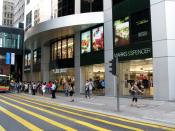Management & Strategy Report
Assignment 2
Case Study on Marks and Spencer's
word Count 2732
Executive Summary
1. Key changes in market4
Clothing4
Food4
Financial Services5
Home-wares5
International5
2. Generic Strategies7
Decline in profits cause concern7
What strategy did they follow?7
Blind ignorance?8
Vandevelde arrives in 20008
Differentiation strategy8
Cost-leadership elements9
Possible distraction from M&S's new strategy9
3. Ansoff's Matrix10
Strategic direction followed under Peter Salsbury11
Withdrawal from markets11
Acquiring Littlewoods chain11
Large-scale promotional campaign11
Severing links with UK suppliers11
Financial services, International markets and Home & Internet shopping11
January 2000 to March 2002 - Arrival of Luc Vandevelde12
Strategic direction followed under Vandevelde12
Main areas of Vandevelde's Market Penetration Strategy12
New clothing ranges12
4. Organisational Culture13
Cultural Web13
Changes in organisational culture14
Overhaul helped change culture15
1. Key changes in market
Over the past decade M&S's competitive advantage seems to have eroded. The following aims to determine the key changes in the market that contributed to this decline.
It is important to first of all state that M&S were not just in one market but several. The main markets, in no particular order, being:
1.Clothing
2.Food
3.Financial services
4.Home-Wares
5.International
Clothing
M&S built up its competitive advantage here through stocking 'generic clothing' that was 'built on basics' (Document A, p.1045). However, they did not at any time assess the market or research customer trends and this left a gap which competitors quickly filled.
People change. Fashions change, and to ignore this fact is silly. With the onset of the recession in the early 1990's customer's needs had changed and this was reflected in their spending patterns. They main changes being
1.More fashion conscious especially in younger age group
2.Customers had less disposable income therefore needed cheaper clothes
M&S failed to...



M&S case analysis
Great analysis! It really shows how well you understand the topics covered in your class such as differentiation and low-cost leader. Great Job!
1 out of 1 people found this comment useful.